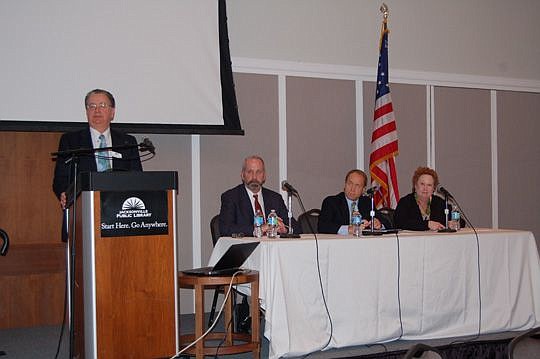
Depending on who you ask, proposed regulations on carbon dioxide emissions from power plants are either a sign of America’s leadership heading off global climate change, new rules not likely to be met that are an incursion on states’ rights or a set of rules with a 90 percent chance of being thrown out by the courts.
That was the gist of a symposium hosted Wednesday by JEA on the Environmental Protection Agency’s proposed Clean Power Plan. The regulations would significantly reduce carbon dioxide emissions from power plants beginning in 2020.
Mike Hightower, JEA board chair, said the board is concerned about the long-term financial and operational impacts of the proposed regulations.
“Most important is how the regulations could impact our rate-payers,” he said.
Regulations to reduce carbon dioxide emissions from power plants by 30 percent before 2030 must be established by June. Each state would have to submit its plan for compliance to EPA by June 2016.
Comments from electricity providers, environmental groups and the general public will be accepted by the EPA through Dec. 1.
“This is the start in an effort to work together on a complex and far-reaching rule that will impact everyone in the community,” Paul McElroy, JEA managing director and CEO, said of the symposium.
Kenneth Mitchell is special assistant to the director of the EPA Region 4 Clean Air Program and the person who will evaluate the plans of Southeast states when they are submitted. He said the purpose of the new regulations is to “do our part as a nation to slow climate change.”
He said the scientific community believes climate change is being caused by greenhouse gases, including carbon dioxide. The largest emitters, 32 percent of the total, are power plants burning fossil fuels.
When the regulations are fully implemented and emissions are reduced, Mitchell said America will take advantage of as much as $93 billion in public health and climate benefits and the average household electric bill will be reduced by 8 percent.
“Nobody believes that except the EPA and some environmentalists,” said attorney Jeff Holmstead, head of the environmental strategies group at Bracewell & Giuliani, a law firm with offices in the U.S., Dubai and London.
“I think it’s important we address climate change, but it’s also important to be honest about what it will cost,” he said. “Even the EPA agrees this will significantly increase the rate you will pay for electricity.”
However, Holmstead added, the EPA contends the savings will come through consumers using and buying less electricity.
He questioned whether EPA will be able to enforce the deadlines set for the new regulations. Plans created by the power industry will have to be approved by state legislatures in order to be enforced by state agencies. And that process alone could take years.
“The mere fact there is a deadline doesn’t mean it will be met,” he said.
He also questioned the EPA’s authority.
“The Supreme Court has said the EPA has the authority to regulate carbon dioxide, but only by implementing programs allowed in the Clean Air Act,” Holmstead said. “This rule will not withstand that test.”
Theresa Pugh, director of environmental services for the American Public Power Association, said the regulations are designed to motivate power providers to use less coal and more natural gas to generate electricity. That will impact each state differently, depending on each state’s access to natural gas.
Since Florida doesn’t produce natural gas, it would have to be piped in from other states, requiring a major expansion of infrastructure.
“Florida would need a 105 percent pipeline increase,” Pugh said. “It’s not a philosophical issue, it’s logistics.”
At the conclusion of the symposium, McElroy said the power industry in general and JEA in particular, are in the early stages of deciding how to deal with the new regulations that aren’t yet known.
“We in the industry have to be cautious and not jump to conclusions. We will work with regulators, environmentalists and consumers,” he said.
JEA plans another symposium after the EPA publishes its final rule in June.
@DRMaxDowntown
(904) 356-2466